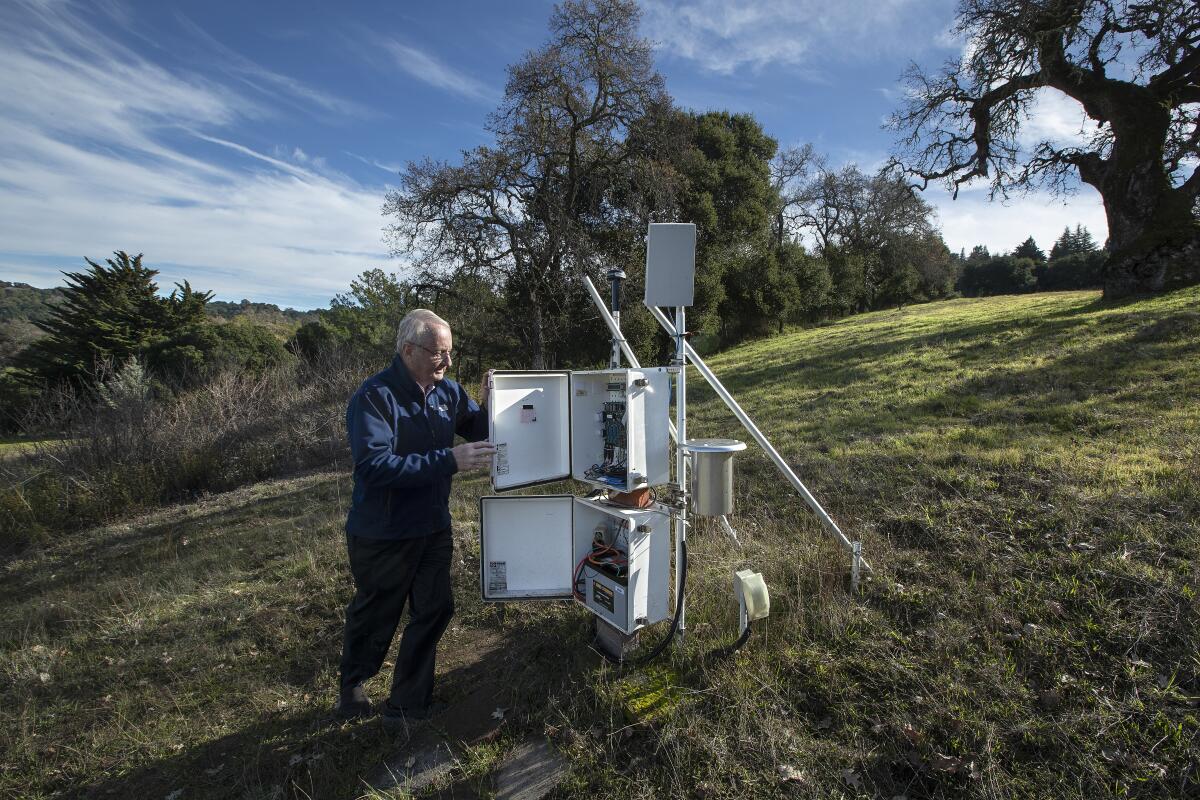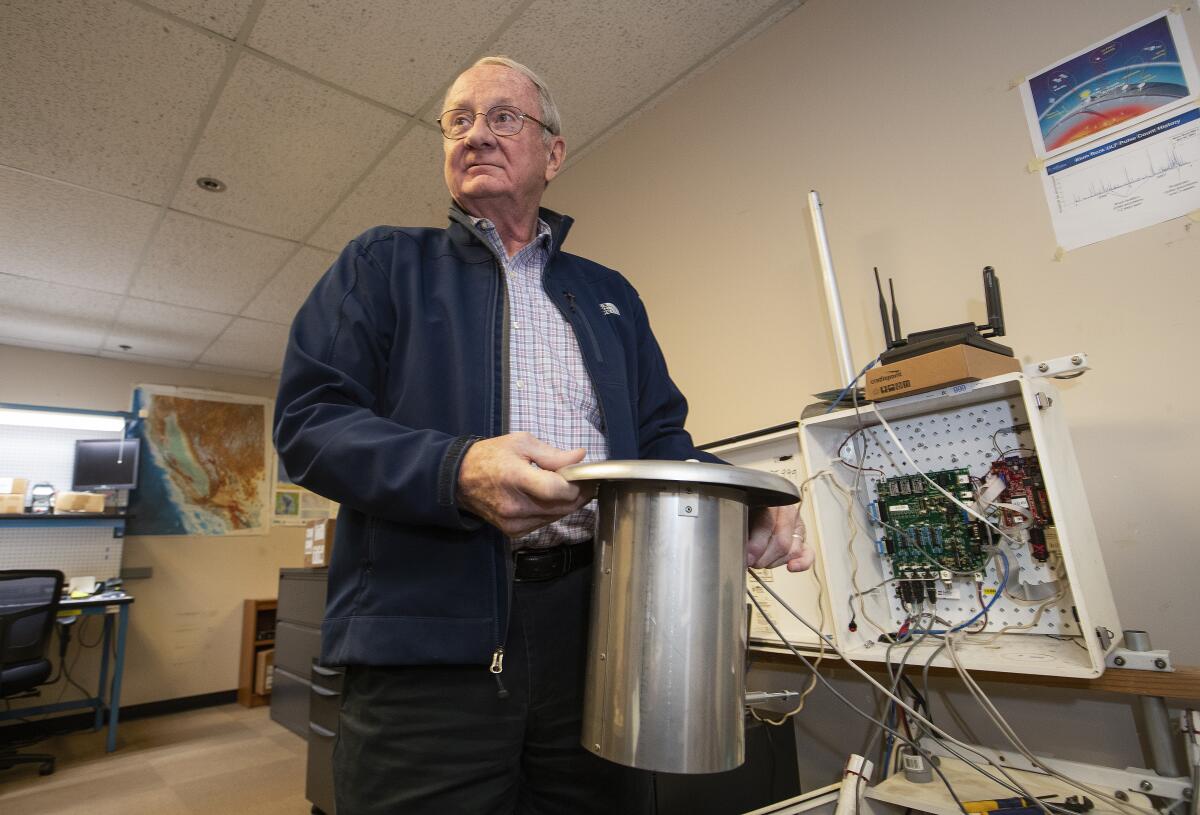This firm spent big to see if ‘earthquake lights’ could warn of temblors. It didn’t work

Aerospace engineer Tom Bleier tramped up a Bay Area hill on a recent weekday to inspect a sensor designed to detect whether the nearby San Andreas fault was about to shake the earth.
It was part of a network of 115 sensors deployed along the California coast to act as ears capable of picking up these hints, called electromagnetic precursors. If they exist, they could serve as an early warning system for earthquakes.
They could also provide a key to understanding spooky electric discharges known as “earthquake lights,” which some seismologists say can burst out of the ground before and during certain seismic events.
Bleier had reason to look forlorn. After spending 20 years and $30 million, he and other engineers at Stellar Solution Inc.’s QuakeFinder.com project never snared a clear indicator of a deadly seismic hazard. But that didn’t keep them from trying.
A budget cutback did.
In December, Stellar Solutions slashed the project’s operating funds — a victim of the company’s decision to focus on its more productive defense and satellite work. Its data analyses team was dismantled, perhaps indefinitely.
Bleier, 74, who recently retired, volunteers in a two-man skeleton crew tasked with simply keeping the sensors running through 2020.

“If our funding goes completely dry,” Bleier said, “we’ll pull the sensors out of the ground, ending the only project of its kind in the United States.”
Bleier’s research is separate from the U.S. Geological Survey’s early warning system that feeds apps such as MyShake and ShakeAlertLA, designed to warn people about expected shaking coming from distant earthquakes. But its demise shutters a project that originally held much promise.
Like the search for evidence of extraterrestrial intelligence, scientists have been hunting unsuccessfully for decades to establish the existence of precursors. Similarly, some researchers have faced derision for latching onto phenomena thought to precede quakes — strange animal behavior, shifts in underground water pressure, electromagnetic emissions, weird lights.
The USGS acknowledges that tectonic stress may, under certain conditions, generate electromagnetic pulses which, upon reaching the surface, could create luminosities ranging from incandescent orbs to aurora-like curtains of blue and white light.
But a study to confirm their existence is out of the question.
“That would be a death-knell of a career move because earthquake prediction is not thought to be a promising path in general,” said Susan Hough, a seismologist with the USGS in Pasadena.
Her book, “Predicting the Unpredictable: The Tumultuous Science of Earthquake Prediction,” points out that nobody sounded the alarm before the 2010 quake in Haiti that killed an estimated 100,000 people; the 2010 quake in Chile that killed 525 people, or the quake that rocked Japan in 2011 that killed 15,000 people and triggered a tsunami that severely damaged a nuclear power plant.
“Who wants to say, ‘I’m going to be the world’s greatest expert on earthquake lights?’” she asked.
The answer to that question is Bleier, for one. “I’ll never give up the search,” said the self-described “geek in a positive sense” who persuaded Celeste Ford, chief executive officer and founder of Stellar Solutions, to take on the project as a humanitarian R&D initiative.
“We’ve given our hearts and souls to QuakeFinder,” Ford said in an interview. “But pinning down precursors is not a one-company job.”
The bottom line: It takes about $4 million a year to operate its sensors in earthquake-prone regions including California, Peru, Taiwan, Greece, Chile and Indonesia and pay staffers to process the data they gather.
“That’s an awful lot of money for one company to shoulder forever,” Ford said. “So, we’re hitting the pause button.”
A month ago, the results of QuakeFinder’s search for earthquake pulses from 2005 to 2018 were published in the scientific journal Computers and Geosciences.
To hear QuakeFinder tell it, they suggest that small precursor signals exist, but they are masked by natural and man-made background electromagnetic noise. “We need to figure out a way to extract that signal from all that noise,” Bleier said. “That would require more funding.”
The project’s loyal supporters include John Derr, a former USGS geophysicist whose report on earthquake lights in the 1973 issue of the Geological Survey’s Earthquake Information Bulletin drew widespread attention, including from the New York Times.
“Precursors could be used to develop an earthquake warning system,” Derr, 78, said. “If that isn’t important, I’ll eat my hat!”
“Unfortunately,” he added, “this subject is on the dark side of seismology and could destroy your career if you study it.”
Another proponent is Friedemann Freund, a retired NASA scientist and adjunct professor at San Jose State University who has investigated dozens of accounts of earthquake lights.
Stellar Solutions provided the lion’s share of QuakeFinder’s funding since it was launched in 1994, but other donors including NASA and billionaire Elon Musk pulled out their checkbooks.
Its sensors and a footlong satellite launched into orbit on a Russian rocket in 2003 were intended to be the first step toward development of precise earthquake forecasts.
But the satellite quit working after 18 months, and the sensors are so sensitive that engineers haven’t been able to separate potential whispers of quake pulses from natural and man-made background noise.
The magnitude 6 South Napa earthquake of 2014 near San Francisco didn’t pick up enough blips to indicate an imminent quake. “That was a giant disappointment,” Bleier said.
Bleier is scrambling to keep the project alive. Proposals under consideration include a “contest” that would invite participants to sift through 70 terabytes of data collected over the last two decades. He remains convinced there is a breakthrough out there that could potentially save lives and property.
More to Read
Start your day right
Sign up for Essential California for news, features and recommendations from the L.A. Times and beyond in your inbox six days a week.
You may occasionally receive promotional content from the Los Angeles Times.







